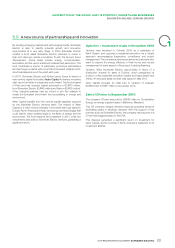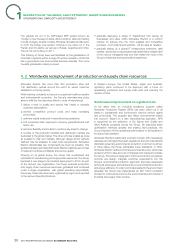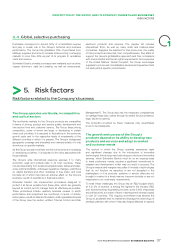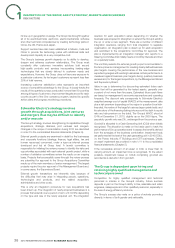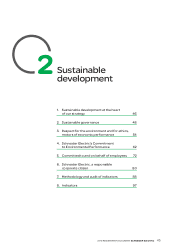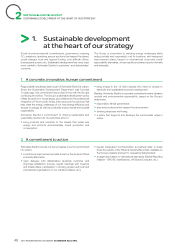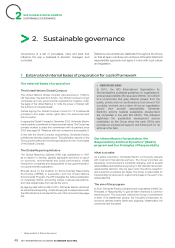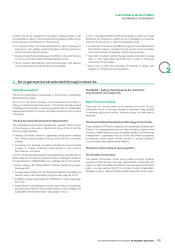APC 2010 Annual Report Download - page 41
Download and view the complete annual report
Please find page 41 of the 2010 APC annual report below. You can navigate through the pages in the report by either clicking on the pages listed below, or by using the keyword search tool below to find specific information within the annual report.
DESCRIPTION OFTHEGROUP, ANDITSSTRATEGY, MARKETS ANDBUSINESSES
1
RISK FACTORS
The Group’s human resources strategy is designed to create
a motivating working environment. Specifi c policies have been
developed covering international mobility, career development,
training, compensation and managing talent. The Group’s
expatriates help prepare the future of its business, build local teams
and assemble the necessary skill sets in targeted regions. They are
tasked with identifying and preparing local successors. The Group
places considerable emphasis on training to expanding its skills
base and retaining employees, thanks to the Schneider Electric
University, its business academies and its leadership programs.
Industrial and environmental risks
The Group may be the subject of product
liability claims and other adverse effects due
to defective products, design faults or harm
caused to persons and property
Despite its testing and quality procedures, the Group’s products
might not operate properly or might contain design faults or defects,
which could give rise to disputes in respect of its liability as seller or
manufacturer, notably in Europe, where liability related to defective
products could lead to a loss of revenue, claims under warranty and
legal proceedings. Such disputes could result in a fall-off in demand
or harm Schneider Electric’s reputation for safety and quality. To
prevent or limit these risks, the Group recalls products if there are
any doubts whatsoever that a product or one of its components is
not 100% safe in respect of people and/or equipment. At the end
of 2009, the Group launched a broad recall campaign concerning a
range of low voltage capacitors produced between 2004 and 2008.
This campaign continued in 2010 and will also be run in 2011.
Some of the expenses incurred by Schneider Electric in the context
of its product recall are covered by the liability insurance program
described in the “Insurance” paragraph below.
The Group recorded a provision for product risk in an amount
of EUR409million in the fi nancial statements for the year ended
December 31, 2010 (see note 23 to the consolidated fi nancial
statements).
The Group’s plants and products are subject to
environmental regulations
The Group’s plants and products are subject to extensive and
increasingly stringent environmental laws and regulations in all of
its host countries.
To limit risks related to the environment in general, the Group is
involved in a process to continuously improve the environmental
performance of its plants and products. In 1992, the Group
published a formal environmental policy designed to improve
manufacturing processes, promote eco-design and integrate
customer concerns in the area of environmental protection. This
policy also aims to identify, assess and prevent environmental
risks, in order to guarantee full compliance with all environmental
laws and regulations applicable to the Group’s businesses,
particularly those in force in the European Union and considered
more rigorous (notably the WEEE directives and REACH program).
Environmental provisions are booked when the risks can be reliably
measured or it is probable that clean-up work will be performed
and the related cost can be reasonably estimated. Provisions
for environmental risks totaled EUR55million for the year ended
December31, 2010. No estimate is made of the potential cost of
unidentifi ed environmental risks. The Group expects its spending
on environmental compliance programs to increase as a result of
changes to existing environmental regulations and the introduction
of new regulations.
There can be no guarantee that the Group will not be required to
pay signifi cant fi nes or compensation as a result of past, current
or future breaches of environmental laws and regulations by
companies that are currently or were previously members of the
Group. This exposure exists even if the Group is not responsible
for the breaches, in cases where they were committed in the past
by companies or businesses that were not part of the Group at the
time.
The Group may be exposed to the risk of claims for breaches of
environmental laws and regulations. Such claims could adversely
affect the Group’s fi nancial position and reputation, despite
the efforts and investments made to comply at all times with all
applicable environmental laws and regulations.
If the Group fails to conduct its businesses in full compliance with
the applicable environmental laws and regulations, the judicial
or regulatory authorities could require the Group to conduct
investigations and/or implement costly clean-up measures to deal
with the current or past contamination of current or former facilities
or off-site waste disposal facilities, and to scale back or temporarily
or permanently close facilities in accordance with the applicable
environmental laws and regulations.
2010 REGISTRATION DOCUMENT SCHNEIDER ELECTRIC 39






